Advertisement
Grab your lab coat. Let's get started
Welcome!
Welcome!
Create an account below to get 6 C&EN articles per month, receive newsletters and more - all free.
It seems this is your first time logging in online. Please enter the following information to continue.
As an ACS member you automatically get access to this site. All we need is few more details to create your reading experience.
Not you? Sign in with a different account.
Not you? Sign in with a different account.
ERROR 1
ERROR 1
ERROR 2
ERROR 2
ERROR 2
ERROR 2
ERROR 2
Password and Confirm password must match.
If you have an ACS member number, please enter it here so we can link this account to your membership. (optional)
ERROR 2
ACS values your privacy. By submitting your information, you are gaining access to C&EN and subscribing to our weekly newsletter. We use the information you provide to make your reading experience better, and we will never sell your data to third party members.
Origins Of Life
Metals could have catalyzed amino acid synthesis on early Earth
Copper, cobalt, vanadium, and nickel ions alone can drive metabolic reaction usually catalyzed by enzymes
by Alla Katsnelson, special to C&EN
November 22, 2021

Amino acids are molecules fundamental to living organisms because they combine to build proteins, the workhorses of the cell. One metabolic pathway that produces amino acids involves transamination, a reaction in which an amino group is transferred to a keto acid. Normally, an enzyme or a cofactor catalyzes transamination. But Joseph Moran, a chemist at the University of Strasbourg, wondered whether this process happened without enzymes in the earliest days of life on Earth.
At high temperatures, metal ions can catalyze transamination. A new study shows that several metals likely abundant on early Earth can do the catalysis under biological conditions, at room temperature (J. Am. Chem. Soc. 2021, DOI: 10.1021/jacs.1c08535). The study’s top performers, which produced the highest yield of amino acids, were copper, cobalt, vanadium, and nickel.
Moran and his team conducted multiple analyses to determine how these metals catalyze the amino group transfer. “The metals essentially work in two different ways,” Moran says. Copper and cobalt stabilize an intermediate imine, and vanadium accelerates the reaction by increasing the acidity of a key C–H bond. Nickel does a bit of both.
Moran says the results support the idea that the chemical framework for metabolism could have been present from the start, before complex proteins and genetic molecules like RNA evolved on Earth.





Join the conversation
Contact the reporter
Submit a Letter to the Editor for publication
Engage with us on Twitter